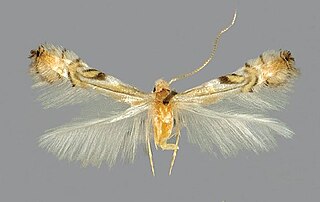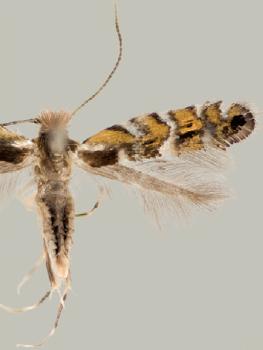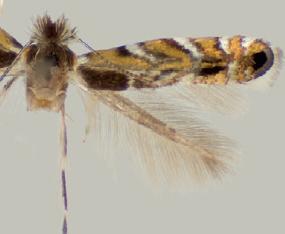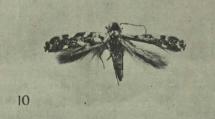
Gracillariidae is an important family of insects in the order Lepidoptera and the principal family of leaf miners that includes several economic, horticultural or recently invasive pest species such as the horse-chestnut leaf miner, Cameraria ohridella.

Philodoria is a genus of moths in the family Gracillariidae. All species are endemic to Hawaii. It was first described by Lord Walsingham in 1907.

Phyllonorycter apparella, the aspen leaf blotch miner moth, is a moth of the family Gracillariidae. It is found in most of Europe. It is also present in Turkey and North America.

Phyllocnistis is a genus of moths in the family Gracillariidae.
Corythoxestis aletreuta is a moth of the family Gracillariidae. It is known from Ethiopia, Nigeria, Rwanda, Tanzania and Uganda.
Aristaea bathracma is a species of moth of the family Gracillariidae. It is known from China, Thailand, Japan (Honshū), the Russian Far East, Mozambique, South Africa, Réunion and Uganda.

Stomphastis thraustica is a moth of the family Gracillariidae. It is known from Democratic Republic of Congo, Congo, Central African Republic, Ghana, Nigeria, Namibia, Zimbabwe, South Africa, Madagascar, Malaysia, Indonesia and India. It was recently also recorded in China, where there are over ten overlapping generations per year.
Pleiomorpha homotypa is a moth of the family Gracillariidae. It is found in South Africa.
Conopobathra gravissima is a moth of the family Gracillariidae. It is known from India, Indonesia (Java), Malaysia (Selangor), the Bismarck Archipelago, Thailand, South Africa, Kenya, Namibia and Zimbabwe.
Acrocercops coffeifoliella is a moth of the family Gracillariidae. It is known from India, Sri Lanka, Indonesia (Java), Réunion and Madagascar.

Phyllocnistis insignis is a moth of the family Gracillariidae, found throughout the United States.
Phyllocnistis liquidambarisella is a moth of the family Gracillariidae, known from the United States. The hostplant for the species is Liquidambar styraciflua. They mine the leaves of their host plant. The mine has the form of a long, winding, linear mine on the upperside of the leaf. It is rather indistinct, without any central line of frass.
Acrocercops albinatella is a moth of the family Gracillariidae, known from Quebec and the United States.

Macrosaccus morrisella is a moth of the family Gracillariidae. In North America it is known from Manitoba, Ontario, and Quebec, south and west to Texas and Colorado.

Macrosaccus uhlerella is a moth of the family Gracillariidae. It is known from Illinois, Missouri, New York, Colorado and Texas in the United States.
Caloptilia ferruginella is a moth of the family Gracillariidae. It is known from the United States (California).
Caloptilia scutellariella is a moth of the family Gracillariidae. It has been recommended that this species be further studied as its placement within the genus Caloptilia is in need of clarification. It is known from Ontario, Canada, and Ohio and Michigan in the United States.
Caloptilia perseae is a moth of the family Gracillariidae. It is known from Cuba and Florida in the United States.

Micrurapteryx occulta is a moth of the family Gracillariidae. It is recorded from across North America in the northern half of the continent, in Canada from the Maritime Provinces to British Columbia, north to northernmost Yukon. In the United States it has been found in Connecticut, Kentucky, Illinois, Colorado, Utah, Nevada, and California. The habitat consists of meadows, the edge of forests, open ponderosa pine forests, alpine meadows, the sea shore, and probably other habitats, from sea level to high elevations in the mountains, where suitable hosts occur.

Acrocercops panacivagans or Eumetriochroa panacivagans is a moth of the family Gracillariidae. It is endemic to New Zealand. In 2019 Robert Hoare and colleagues proposed that this species be provisionally assigned to the genus Eumetriochroa.





